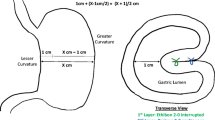Abstract
Aim
Retrospective multicenter analysis of the results of two different approaches for band positioning: perigastric and pars flaccida.
Methods
Data were collected from the database of the Italian Group for LapBand® (GILB). Patients operated from January 2001 to December 2004 were selected according to criteria of case–control studies to compare two different band positioning techniques: perigastric (PG group) and pars flaccida (PF group). Demographics, laparotomic conversion, postoperative complications, and weight loss parameters were considered. Data are expressed as mean ± standard deviation.
Results
2,549 patients underwent the LapBand System® procedure [age: 40 ± 11.7 years; sex: 2,130 female, 419 male; body mass index (BMI): 46.4 ± 6.9 kg/m2; excess weight (EW): 60.1 ± 23.6 kg; %EW: 90.1 ± 32.4]. During this period 1,343/2,549 (52.7%) were operated via the pars flaccida (PF group) and 1,206/2,549 (47.3%) via the perigastric approach (PG group). Demographics for both groups were similar. Thirty-day mortality was absent in both groups. Operative time was significantly longer in the PG group (80 ± 20 min versus 60 ± 40 min; p < 0.05). Hospital stay was similar in the two groups (2 ± 2 days). Laparotomic conversion was significantly higher in the PG group (6 versus 2 patients; p < 0.001). Overall postoperative complication rate was 172/2,549 (6.7%) and was linked to gastric pouch dilation/slippage (67/172), intragastric migration/erosion (17/172), and tube/port failure (88/172). Gastric pouch dilation and intragastric migration were significantly more frequent in the PG group: 47 versus 20 (p < 0.001) and 12 versus 5 (p < 0.001), respectively. Patients eligible for minimum 3-year follow-up were 1,118/1,206 (PG group) and 1,079/1,343 (PF group). Mean BMI was 33.8 ± 12.1 kg/m2 (PG group) and 32.4 ± 11.7 kg/m2 (PF group) (p = ns), and mean percentage excess weight loss (%EWL) was 47.2 ± 25.4 and 48.9 ± 13.2 in PG and PF groups, respectively (p = ns).
Conclusions
Significant improvement in LapBand System® results with regard to laparotomic conversion and postoperative complication rate, with similar weight loss results, was observed in the pars flaccida group.


Similar content being viewed by others
References
Belachew M, Legrand MJ, Vincente V et al (1995) Laparoscopic placement of adjustable silicone gastric band in the treatment of morbid obesity: how to do it. Obes Surg 5:66–70
Favretti F, Cadiere GB, Segato G et al (1995) Laparoscopic adjustable silicone gstric banding: technique and results. Obes Surg 5:364–371
Angrisani L, Furbetta F, Doldi SB et al (2003) Lap Band®—Adjustable Gastric Banding System. The Italian experience with 1863 patients operated on 6 years. Surg Endosc 17:409–412
O’Brien P, Brown W, Smith A et al (1999) Prospective study of a laparoscopically placed, adjustable gastric band with treatment of morbid obesity. Br J Surg 85:113–118
O’Brien P, Dixon JB, Laurie C, Anderson M (2005) A prospective randomized trial of placement of the laparoscopic adjustable gastric band: comparison of the perigastric and pars flaccid pathways. Obes Surg 15:820–826
Disclosures
Nicola Di Lorenzo, Francesco Furbetta, Franco Favretti, Giovanni Segato, Maurizio De Luca, Giancarlo Micheletto, Marco Zappa, Paolo De Meis, Ezio Lattuada, Michele Paganelli, Marcello Lucchese, Nicola Basso, Francesco D. Capizzi, Leonardo Di Cosmo, Vincenzo Mancuso, Simona Civitelli, Angelo Gardinazzi, Cristiano Giardiello, Augusto Veneziani, Marcello Boni, Vincenzo Borrelli, Angelo Schettino, Pietro Forestieri, Vincenzo Pilone, Ida Camperchioli, and Michele Lorenzo have no conflicts of interest or financial ties to disclose.
Author information
Authors and Affiliations
Corresponding author
Rights and permissions
About this article
Cite this article
Di Lorenzo, N., Furbetta, F., Favretti, F. et al. Laparoscopic adjustable gastric banding via pars flaccida versus perigastric positioning: technique, complications, and results in 2,549 patients. Surg Endosc 24, 1519–1523 (2010). https://doi.org/10.1007/s00464-009-0669-y
Received:
Accepted:
Published:
Issue Date:
DOI: https://doi.org/10.1007/s00464-009-0669-y




